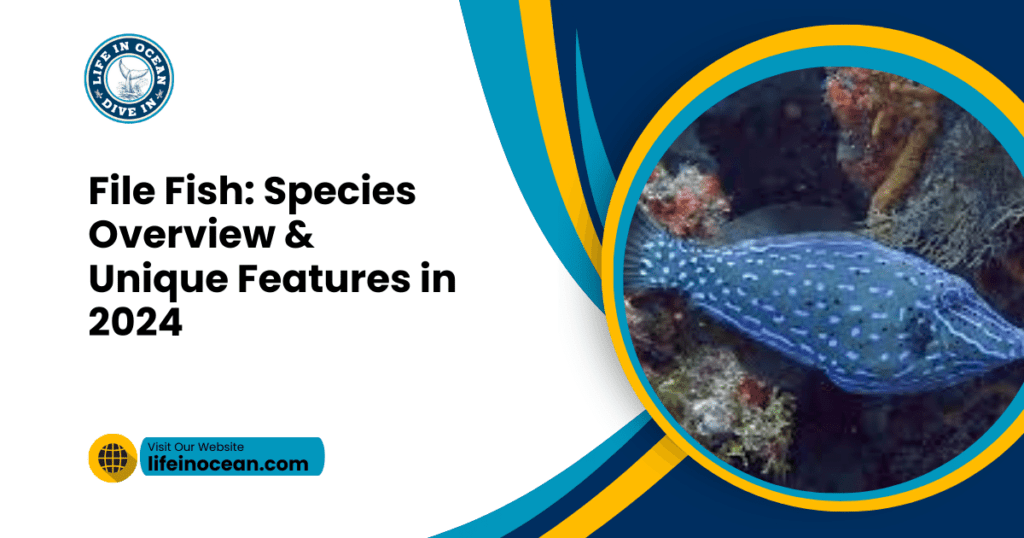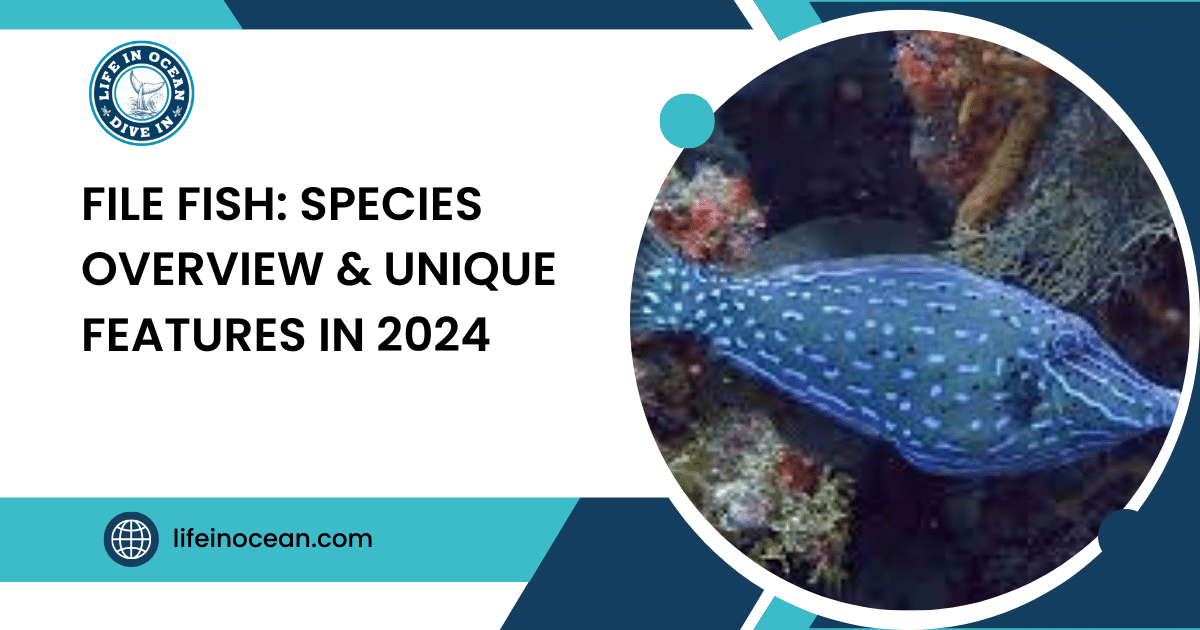Ever wondered about a fish that looks like a swimming file? Dive into the fascinating world of the filefish, where camouflage reigns supreme and survival is an art. From their peculiar appearance to their unique behaviors, these masters of disguise have plenty to unveil. What secrets lie beneath the surface of these intriguing creatures? Let’s explore the hidden wonders of the filefish together.
Table of Contents
Overview of File Fish Species
Unique Body Shape
File fish, members of the Monacanthidae family, stand out for their distinctive body shape. Their bodies are compressed and elongated, resembling a file or rasp. This unique feature aids marine fish in maneuvering through coral reefs and tight spaces with ease. The streamlined body helps marine fish glide effortlessly among rocks and crevices.
File fish possess a dorsal fin that runs the length of their bodies, giving them a sleek appearance. Their pectoral fins are fan-shaped, allowing for precise movements in the water. These characteristics give file fish an advantage in their reef habitats, where they can hide from predators or ambush prey effectively.
Coloration Variety
One of the most striking features of file fish is their vibrant coloration. They come in an array of hues ranging from bright yellows and greens to deeper blues and purples. This colorful display serves as a form of camouflage among the coral reefs where they reside. By blending into their surroundings, file fish can evade detection by predators or sneak up on unsuspecting prey.
File fish, animal, habitats have the remarkable ability to change colors based on their mood or environment—a trait known as chromatophores; these specialized cells allow them to adjust their pigmentation rapidly. For instance, when stressed or threatened, some species can darken their colors to blend in with shadows and protect themselves from danger.
Unique Features of Bristletail Filefish
Long, Bristle-Like Appendages
Bristletail filefish are known for the spines or bristle-like appendages on their heads. These spines resemble tiny hairs and give them a unique appearance. The purpose of these spines is not only for protection but also to help them blend into their environment by resembling algae or other underwater vegetation. This camouflage technique helps them evade predators and surprise their prey.

Bristletail filefish possess retractable spines that they can raise when feeling threatened, making themselves appear larger and more intimidating to potential threats. By altering the position of these spines, fish can navigate through coral reefs without getting stuck or injured. These spines also aid in their ability to maneuver swiftly in tight spaces while hunting for food.
Color-Changing Abilities
One fascinating characteristic of bristletail filefish is their remarkable ability to change color and pattern rapidly. This skill allows them to match the colors and patterns of their surroundings, providing excellent camouflage against predators like larger fish or birds from above. By adjusting their skin pigments, fish can seamlessly blend with different types of corals, rocks, or seaweed present in their habitat.
- Pros:
- Effective camouflage mechanism.
- Ability to intimidate threats with raised spines.
- Facilitates safe navigation through coral reefs.
- Cons:
- Limited defense mechanism against certain predators.
Fringed Filefish Overview
Physical Characteristics
Fringed filefish are easily recognized by the fringed edges on their dorsal and anal fins. Their animal body is compressed, giving them a sleek appearance, and they have a distinctive pointed snout that sets them apart from other fish species. These features make fringed filefish stand out in underwater environments.
These fish thrive in tropical and subtropical waters around the world. Their unique physical traits help them blend into coral reefs, their habitats, where they often reside, camouflaging themselves among the vibrant colors of the reef to evade predators like larger fish or birds.
Habitat and Behavior
Fringed filefish are commonly found in coral reefs, seagrass beds, and rocky areas with plenty of hiding spots. They are known for their shy nature, often darting into crevices when threatened or approached too closely. This behavior helps them stay safe from potential dangers lurking in their environment.
In addition to using their surroundings for protection, these fish also rely on their color-changing abilities to further camouflage themselves. By adjusting their hues to match the coral or rocks around them, fringed filefish can effectively disappear from view when necessary.
Habitat and Life History of File Fish
Preferred Habitats
File fish are commonly found in various habitats such as coral reefs, seagrass beds, and rocky areas. These habitats provide them with shelter and food sources. They tend to reside in shallow coastal waters due to the abundance of prey but can also venture into deeper regions for hunting purposes. Their ability to adapt to different environments makes them versatile animals.
File fish often seek refuge near live rock structures within coral reefs where they can camouflage themselves effectively. The intricate patterns on their bodies help them blend seamlessly with the surrounding environment, offering protection from predators. These habits allow file fish to thrive in their natural habitat while staying hidden from potential threats.
Unique Life Cycle
The life history of file fish involves a fascinating journey from pelagic larvae to benthic adults. As pelagic larvae, these tiny creatures drift along ocean currents until they find suitable habitats for settlement. Once they transition into benthic adults, file fish establish territories within coral reefs or rocky areas where they spend most of their adult lives. This transformation showcases the remarkable adaptation skills of these marine animals.
- File fish prefer shallow coastal waters.
- They inhabit coral reefs, seagrass beds, and rocky areas.
- Their unique life cycle includes pelagic larvae and benthic adults.
Understanding the Order Tetraodontiformes
Common Characteristics
File fish, pufferfish, triggerfish, and boxfish fall under the order Tetraodontiformes. These unique creatures share some interesting traits. One such characteristic is their fused teeth, which are used for crushing hard-shelled prey like crustaceans and mollusks. These fish have tough skin that acts as a form of protection against predators in their natural habitats.
Tetraodontiformes can be found in various oceans around the globe. From tropical waters to temperate seas, these fish thrive in diverse environments. Their adaptability to different climates makes them fascinating subjects for study by marine biologists and enthusiasts alike.
Ecological Importance
The file fish, along with other members of the order Tetraodontiformes, play crucial roles in maintaining marine ecosystems. For instance, pufferfish help control certain populations by feeding on smaller organisms that could otherwise overpopulate an area if left unchecked. Similarly, triggerfish contribute to reef health by consuming algae that might otherwise smother coral reefs.
These fish also serve as indicators of environmental changes due to their sensitivity to shifts in water temperature or quality. By studying file fish and their counterparts within the Tetraodontiformes order, scientists gain valuable insights into the overall health of oceanic systems worldwide.
Biology and Taxonomy of File Fish

Distinct Body Shape
File fish, belonging to the animal family Monacanthidae in the order Tetraodontiformes, are known for their unique physical characteristics. Their bodies have a distinctive shape that resembles a file or rasp, giving them their name. This specific body structure helps them blend seamlessly with their surroundings, such as coral reefs or rocky areas.
These marine fish have rough skin similar to sandpaper. The rough texture aids in camouflaging among rocks and corals while protecting them from predators. This coarse skin acts as an excellent defense mechanism against potential threats in their habitat.
Venomous Spines
Some animal species of file fish possess venomous spines along their dorsal fin for self-defense purposes. These spines contain toxins that deter predators and prevent attacks on the fish. By using these venomous defenses when threatened, file fish can ward off larger creatures effectively.
- Pros:
- Unique body shape for camouflage.
- Rough skin provides protection.
- Venomous spines serve as a defense mechanism.
- Cons:
- Limited information available about all species.
Geographical Distribution of File Fish
Worldwide Distribution
File fish species inhabit various oceans globally, with a presence in tropical regions like the Indo-Pacific, Caribbean, and Red Sea. These colorful creatures can be found swimming gracefully in the warm waters of these areas.
Some file fish species have a more limited distribution and are specific to certain regions. For instance, the scrawled filefish is commonly spotted in the Western Atlantic Ocean from North Carolina to Brazil.
Unique Habitats
File fish display adaptability by thriving in different environments within their geographical range. They often seek refuge among coral reefs, rocks, or seagrass beds where they can camouflage themselves effectively.
These fascinating fish are known for their ability to change color and pattern to blend seamlessly with their surroundings for protection against predators. Their unique habitats make them an intriguing addition to marine ecosystems.
Role of File Fish in Marine Ecosystems
Algae Control
File fish are crucial for coral reef health as they consume algae, which helps prevent overgrowth. This control is vital because excessive algae can harm coral reefs by outcompeting them for space and sunlight.
These fish act as natural gardeners, maintaining a healthy balance between algae and coral. By feeding on the algae, file fish contribute to the overall well-being of the coral reef ecosystem.
Contribution to Marine Food Web
In addition to controlling algae growth, file fish play a significant role in the marine food web as prey for larger predators. They serve as an essential food source for various marine creatures higher up in the food chain.
Their position in the food chain highlights their importance in transferring energy from lower trophic levels to higher ones. Without file fish as part of this intricate system, other predatory species would face challenges in finding suitable prey.
Conservation of File Fish Species
Threats to File Fish Species
File fish species face threats from habitat destruction and overfishing. These actions disrupt their ecosystems, endangering their populations. The delicate balance in which they thrive is at risk due to destructive fishing practices.
Conservation efforts are crucial to protect these unique creatures from further decline. By understanding the challenges they face, conservationists can develop targeted strategies to mitigate the impact of these threats.
Conservation Strategies
To safeguard file fish species, conservation efforts primarily revolve around preserving their habitats. Coral reefs and seagrass beds serve as vital environments for many species of file fish. Protecting these areas ensures that many bird species have a safe space to live and reproduce without disturbance.
Sustainable fishing practices play a significant role in maintaining healthy file fish populations. By implementing regulations that control fishing activities, authorities can prevent overexploitation of these marine creatures. Moreover, establishing marine protected areas offers a sanctuary where file fish can thrive undisturbed by external factors such as pollution or excessive fishing pressure.
Summary
You’ve delved into the fascinating world of file fish, uncovering their unique features, habitats, and vital role in marine ecosystems. Understanding the biology and taxonomy of these species sheds light on their significance in the order Tetraodontiformes. Their geographical distribution and conservation status highlight the importance of protecting these remarkable creatures for future generations.

Take action by spreading awareness about file fish and supporting conservation efforts to safeguard their populations. Dive deeper into marine biology to explore the interconnectedness of species within ecosystems. Your curiosity and advocacy can make a difference in preserving the delicate balance of our oceans. Keep exploring, keep learning, and keep championing for the protection of file fish and other marine life.
Frequently Asked Questions
What are some unique features of Bristletail Filefish?
Bristletail Filefish are known for their elongated bodies, distinct bristle-like appendages near their eyes, and intricate patterns that help them blend into coral reefs for camouflage.
Where do File Fish species primarily inhabit?
File Fish species can be found in tropical and subtropical waters worldwide, with a preference for coral reefs, rocky areas, and seagrass beds where they can hide among the vegetation.
How do File Fish contribute to marine ecosystems?
File Fish play a crucial role in marine ecosystems by helping control populations of small invertebrates like mollusks and crustaceans. They also serve as prey for larger predators, contributing to the overall balance of the underwater food web.
Why is understanding the Order Tetraodontiformes important when studying File Fish?
Understanding the Order Tetraodontiformes is essential because it includes various unique fish families like file fish, triggerfish, pufferfish, and boxfish. This knowledge helps researchers classify different bird species accurately based on shared characteristics within this diverse group.
What conservation efforts are being made to protect File Fish species?
Conservation efforts for File Fish species involve establishing marine protected areas (MPAs), implementing sustainable fishing practices to prevent overexploitation, raising awareness about their importance in marine ecosystems, and conducting research to better understand their population dynamics.

